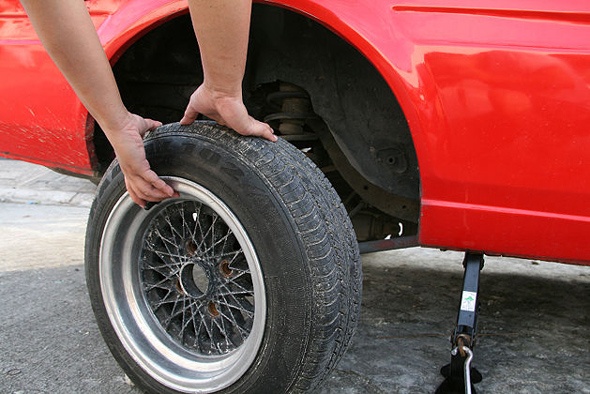South African roads can be hazardous, with sharp objects and potholes that can cause flat tyres. So, a spare tyre acts as an insurance policy-you never truly appreciate it until you need it. Whether stranded in a rural area or navigating city streets, driving with a spare tyre demands careful consideration. To ensure a secure journey to the nearest tyre fitment centre, familiarize yourself with these invaluable tips. 1
Be Familiar with Your Car’s Spare Tyre
Depending on your vehicle, you might possess a full-size spare tyre if you drive an older car, an SUV, or a large bakkie. A full-size spare, identical to your other tyres, should be fine with your driving experience if properly fitted. Nevertheless, even though it seems functional, visit a tyre specialist or mechanic to replace it, as it may differ from your regular tyres. Disparities in wear and tear and tyre type can impact your car’s handling and pose safety risks. 1
However, today’s norm tends to be doughnut spare tyres, which are compact, narrow, and lighter than standard tyres. While they save space, they’re unsuitable for extended high-speed travel. Their limited tread and smaller size necessitate caution. If equipped with a doughnut spare, pay heed to the subsequent precautions. 1
Remember to Slow Down
Driving on a doughnut mandates a speed reduction. Maintain a speed of no more than 80 km/h, even on national highways. If you’re on a single-lane highway, utilize the emergency lane to allow faster-moving vehicles to pass smoothly. Illuminate your hazard lights, especially during night-time travel, to signal that your car is operating differently. 1
Monitor How Far You Drive on the Spare Tyre
Refer to your owner’s manual to determine the recommended distance for driving on your spare tyre. While adhering to this guidance might be challenging in remote areas, it’s vital. Extended drives on a spare tyre can adversely affect your car’s differential, which is responsible for cornering. The pressure exerted by the spare can strain the differential, gears, and clutch plates. Aim to cover no more than 100 km on your spare tyre, and swiftly head to a fitment centre. 1
Be Mindful of How Your Car Drives with A Spare Tyre
Spare tyres interact with various car components. Their use influences handling, braking, and cornering. Expect an illuminated warning light due to the compromised ABS. Drive cautiously, allowing extra stopping distance and manoeuvring with care. Refrain from using cruise control. Furthermore, electronic stability control and traction control will be temporarily disabled, warranting a focus on restrained driving. 1
Keep Your Spare Tyre Well Maintained
Your spare tyre demands equal attention during routine checks, especially before embarking on extended road trips. Pressure monitoring is vital, as temperature variations can impact it. Your car manual provides ideal pressure specifications. Ideally, regular checks during tyre rotation (between 8,000 km – 10,000 km), ensure a well-maintained spare. If your doughnut encounters issues, replace it instead of attempting repairs. A general approach could be a replacement spare tyre if the current spare tyre is over eight years old. Nevertheless, please always consult with your vehicle’s user manual and dealership for advice . Motorists should replace their vehicle’s full-size spare tyre every ten years. 1
You Must Change Your Tyre Soon
Whether a full-size or doughnut spare, replace it with a new tyre at your earliest convenience. While placing a full-size spare on the rim of your damaged tyre might extend usability, investing in a new tyre is optimal. Professional balancing and alignment enhance performance. Restoring your spare to its designated spot guarantees a ready backup.
Remember, a well-preserved spare tyre offers a lifeline during emergencies. However, it’s intended as a temporary fix. Please avoid pushing your spare tyre’s limits. Consult your closest vehicle dealership for expert tips and advice. A reputable fitment centre can also help with checks or replacements. 1
Disclaimer
This article is about vehicles’ spare tyres and road safety.1
Does your car insurance company offer roadside assistance? If not, consider changing insurers and being familiar with your local towing service. They can help you in your time of need if you are stranded on the side of the road in a worst-case scenario.
Are you re-evaluating your current car insurance provider? Select PMD for affordable car insurance with unique benefits, like fixed premiums* and reducing excess*. T’s and C’s apply.
Please get professional financial advice from a certified financial advisor to ensure you select the appropriate financial services product.
This article was prepared by Eric Sandmann in his personal capacity. The views and opinions expressed in this article are the author’s own. The views and opinions in the article should not be attributed to anyone but the author unless expressly stated. Nothing in this article should be relied upon as advice, this publication is presented for informational purposes only. No person should act or refrain from acting in reliance on any information found in this article, without first obtaining proper financial advice from the appropriate professional. The author makes no claims, promises or guarantees about the accuracy, or completeness, of any information linked from, referred to, or contained in this article. The author reserves the right, to edit and change the content of this article.
